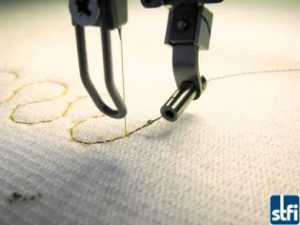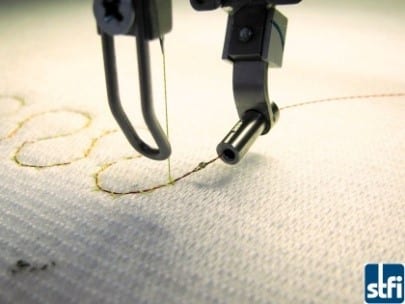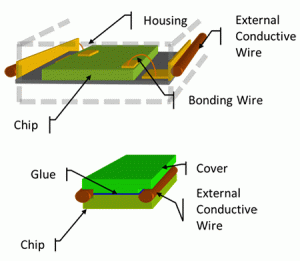
Yarns equipped with LEDs or UHF EPC Gen2 RFID. Usable with regular textile equipment (example of embroidery from the FP7 Pasta Project)
In the past, products such as garments have been labelled with external tags. But things have changed: the size of the base assembly and the efficiency of the manufacturing process are such that electronic components can now be seamlessly integrated into textiles, at a cost potentially suitable for widespread use. Products can now feature embedded RFID capabilities from design to points of sale, as the French company Primo1D reports.
Their so-called E-Thread technology may open new methods and introduce enhanced features associated with higher perceived value. It also has the capability for a variety of applications outside the textile industry.
Innovation in microelectronic packaging allows direct connection of a chip to a set of two conductors behaving as an antenna, a power or a data bus. According to the developers, it is superior to the usual solutions in which the connection to an external conductor is made in two stages: an internal connection to a housing, and a connection of the housing to the outer conductors.
The simplicity of the solution is leading to a size advantage; it is 10 times smaller, a reduction in assembly time and more reliability . Instead of two the novel technology needs only one manufacturing step. The result is a miniature, resilient and competitive solution protected by 18 patents covering the assembly itself, the manufacturing process and some fields of application.
The E-Thread technology is sold by Primo1D. Headquartered at the Minatec Technology Campus in Grenoble, France, and founded in August 2013, the company offers solutions for embedding sparkles of intelligence in objects and materials. It resulted from the international PASTA project. Aim of this project was to bring both worlds, electronics and textile, closer together to result in a more comfortable, easy manufacturable and reliable combination. 16 academic and industrial partners successully researched on electronic packaging and interconnection technology with textile research to realize an innovative approach of smart textile.


















